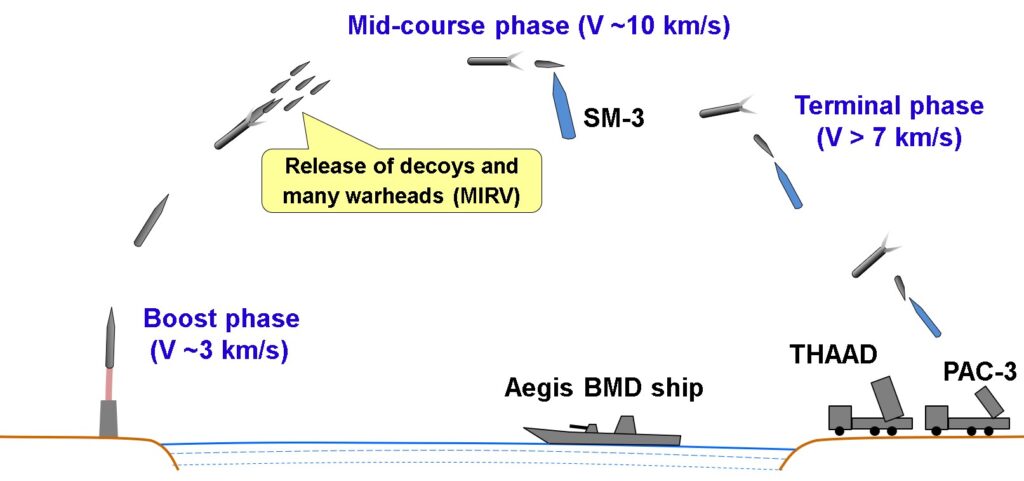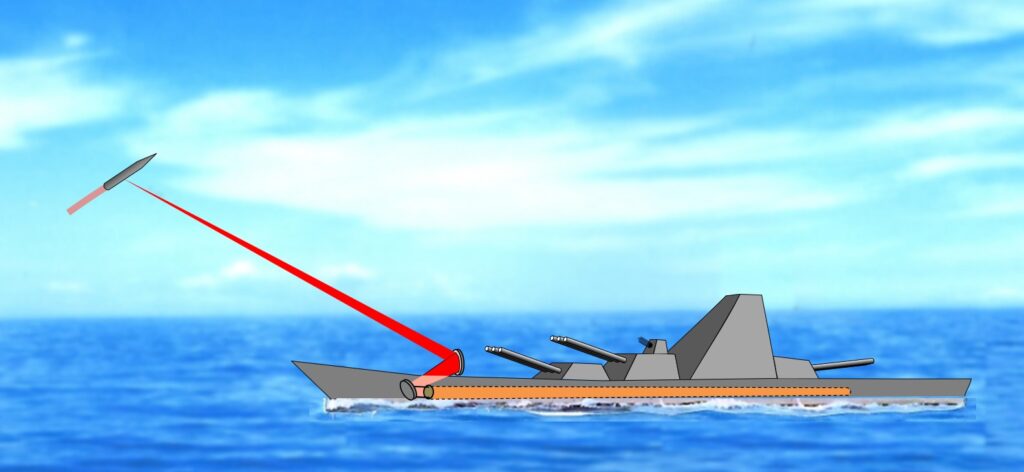Conventional schemes for the missile defense against nuclear missiles are shown in Fig.1.

Fig. 1. Missile defense systems against nuclear missiles.
Although, nuclear missiles in the mid-course phase and/or the terminal phase are the target, the boost-phase interception (BPI) is the best way to shoot down the missiles because their speed is low and it is before releasing the warheads. However, considering the long distance, the BPI can only be achieved by a high-energy laser (HEL) with the speed of light.
Conventionally, such HEL is based on a high-power continuous-wave (CW) laser 1). To intercept a missile, a CW laser beam needs to irradiate the housing of the missile for seconds until it is shot down. However, the targeting technology to irradiate the focused beam at a fixed position on the housing of the fast-moving missile is not easy. Moreover, shooting down a rolling airframe missile by a CW laser is quite difficult. Therefore, we propose to use a pulsed HEL to shoot down a missile (Fig. 2).

Fig. 2. Nuclear missile destruction by a pulsed HEL.
There is another advantage to use a pulsed HEL. Basically, a laser weapon can be useful when the sky is clear. In a rainy or foggy weather, it is not useful. Needless to say, enemy’s missiles can come at any weather. Therefore, the technology of clearing the sky by another high-power laser is important 2) unless the HEL is based on space 3) or in high-altitude air 4). A high-power laser is used to evaporate the rain or the fog to make a clear beam path for the HEL. However, the total volume for the evaporation can be quite large in a windy condition. The required volume is proportional to the product of the wind speed and the laser irradiation time. For a pulsed HEL, the volume becomes the smallest.
We consider the following pulsed chemical lasers are suitable to shoot down the nuclear missiles.
- Chemical oxygen-iodine laser (COIL) 5-7).
- Chemical oxygen laser (COL) 8-11).
Although, chemical lasers are not easy to use due to the handling of hazardous chemicals, they can operate without a large electric power supply. There is no limit in the output energy by preparing a large amount of chemicals and generating an instant chemical reaction.
When such pulsed HEL will be developed, a perfect missile defense system is realized. Consequently, possessing nuclear missiles is just a huge waste of money considering the cost of >1000 million dollars for a single missile. The shot cost of the HEL, on the other hand, is only ~100 dollars.
References
- “The airborne laser,” Proc. of SPIE Vol. 6346, 63461M (2007).
- “Atmospheric thermal blooming and beam clearing by aerosol vaporization,” Proc. of SPIE Vol. 1221, 91-105 (1990).
- “An Overview of the Space-Based Laser (SBL) Program,” Proc. of SPIE Vol. 4632, 181-186 (2002).
- “New defence system using a chemical oxygen-iodine laser in a high-altitude airship,” Proc. of SPIE Vol. 10798, 1079803 (2018).
- “Pulsed COIL review,” Proc. of SPIE Vol. 1980, 181-185 (1992).
- “High pressure pulsed COIL assisted with an instantaneous production of atomic iodine,” Proc. of SPIE Vol. 4184, 124-127 (2001).
- “Consideration of a ship defense with a pulsed COIL,” Proc. of SPIE Vol. 9650, 965003 (2015).
- “Possible high energy laser at 1.27μm,” Applied Optics, Vol. 17, No. 20, 3276-3283 (1978).
- “Chemically Pumped O2(a-X) Laser,” Applied Physics B, Vol. 56, 71-78 (1993).
- “New concepts of realizing a chemical oxygen laser,” Proc. of SPIE Vol. 9251, 92510X (2014).
- “Proposal of a defense application for a chemical oxygen laser,” Proc. of SPIE Vol. 9466, 94660W (2015).